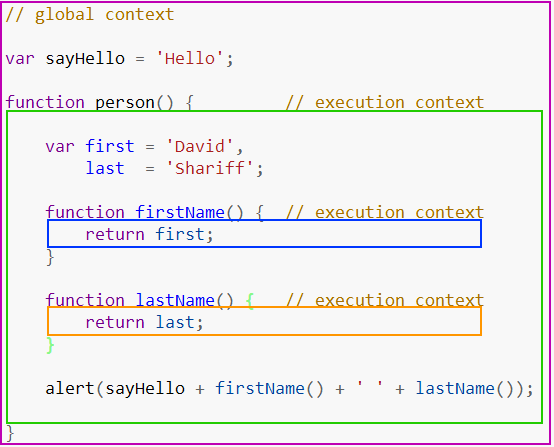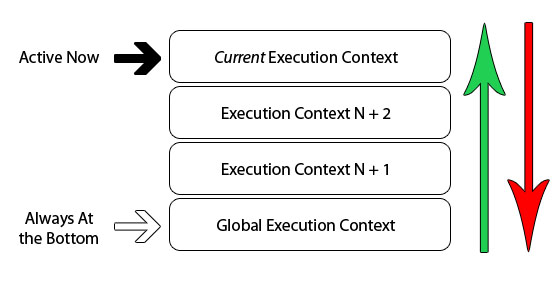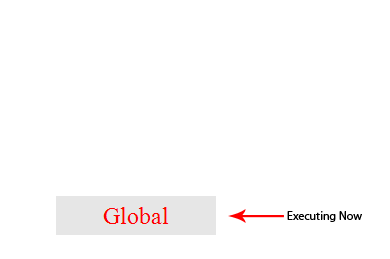

What is execution context & stack in Javascript?
When code is run in JavaScript, the environment in which it is executed is very important, and is evaluated as one of the following:
- Global code – The default envionment where your code is executed for the first time.
- Function code – Whenever the flow of execution enters a function body.
- Eval code – Text to be executed inside the internal eval function.
You can read a lot of resources online that refer to scope, and for the purpose of this article to make things easier to understand, let’s think of the term execution context as the envionment / scope the current code is being evaluated in. Now, enough talking, let’s see an example that includes both global and function / local context evaluated code.

Nothing special is going on here, we have 1 global context represented by the purple border and 3 different function contexts represented by the green, blue and orange borders. There can only ever be 1 global context, which can be accessed from any other context in your program.
You can have any number of function contexts, and each function call creates a new context, which creates a private scope where anything declared inside of the function can not be directly accessed from outside the current function scope. In the example above, a function can access a variable declared outside of its current context, but an outside context can not access the variables / functions declared inside. Why does this happen? How exactly is this code evaluated?
Execution Context Stack
The JavaScript interpreter in a browser is implemented as a single thread. What this actually means is that only 1 thing can ever happen at one time in the browser, with other actions or events being queued in what is called the Execution Stack. The diagram below is an abstract view of a single threaded stack:

As we already know, when a browser first loads your script, it enters the global execution context by default. If, in your global code you call a function, the sequence flow of your program enters the function being called, creating a new execution context and pushing that context to the top of the execution stack.
If you call another function inside this current function, the same thing happens. The execution flow of code enters the inner function, which creates a new execution context that is pushed to the top of the existing stack. The browser will always execute the current execution context that sits on top of the stack, and once the function completes executing the current execution context, it will be popped off the top of the stack, returning control to the context below in the current stack. The example below shows a recursive function and the program’s execution stack:
(function foo(i) {
if (i === 3) {
return;
}
else {
foo(++i);
}
}(0));

The code simply calls itself 3 times, incrementing the value of i by 1. Each time the function foo is called, a new execution context is created. Once a context has finished executing, it pops off the stack and control returns to the context below it until the global context is reached again.
There are 5 key points to remember about the execution stack:
- Single threaded.
- Synchronous execution.
- 1 Global context.
- Infinite function contexts.
- Each function call creates a new
execution context, even a call to itself.
Execution Context in Detail
So we now know that everytime a function is called, a new execution context is created. However, inside the JavaScript interpreter, every call to an execution context has 2 stages:
- Creation Stage [when the function is called, but before it executes any code inside]:
- Create the Scope Chain.
- Create variables, functions and arguments.
- Determine the value of
"this".
- Activation / Code Execution Stage:
- Assign values, references to functions and interpret / execute code.
It is possible to represent each execution context conceptually as an object with 3 properties:
executionContextObj = {
'scopeChain': { /* variableObject + all parent execution context's variableObject */ },
'variableObject': { /* function arguments / parameters, inner variable and function declarations */ },
'this': {}
}
Activation / Variable Object [AO/VO]
This executionContextObj is created when the function is invoked, but before the actual function has been executed. This is known as stage 1, the Creation Stage. Here, the interpreter creates the executionContextObj by scanning the function for parameters or arguments passed in, local function declarations and local variable declarations. The result of this scan becomes the variableObject in the executionContextObj.
Here is a pseudo-overview of how the interpreter evaluates the code:
- Find some code to invoke a function.
- Before executing the
functioncode, create theexecution context. - Enter the creation stage:
Initialize the
Scope Chain.Create the
variable object:Create the
arguments object, check the context for parameters, initialize the name and value and create a reference copy.Scan the context for function declarations:
For each function found, create a property in the
variable objectthat is the exact function name, which has a reference pointer to the function in memory.If the function name exists already, the reference pointer value will be overwritten.
Scan the context for variable declarations:
For each variable declaration found, create a property in the
variable objectthat is the variable name, and initialize the value as undefined.If the variable name already exists in the
variable object, do nothing and continue scanning.Determine the value of
"this"inside the context.
- Activation / Code Execution Stage:
- Run / interpret the function code in the context and assign variable values as the code is executed line by line.
Let’s look at an example:
function foo(i) {
var a = 'hello';
var b = function privateB() {
};
function c() {
}
}
foo(22);
On calling foo(22), the creation stage looks as follows:
fooExecutionContext = {
scopeChain: { ... },
variableObject: {
arguments: {
0: 22,
length: 1
},
i: 22,
c: pointer to function c()
a: undefined,
b: undefined
},
this: { ... }
}
As you can see, the creation stage handles defining the names of the properties, not assigning a value to them, with the exception of formal arguments / parameters. Once the creation stage has finished, the flow of execution enters the function and the activation / code execution stage looks like this after the function has finished execution:
fooExecutionContext = {
scopeChain: { ... },
variableObject: {
arguments: {
0: 22,
length: 1
},
i: 22,
c: pointer to function c()
a: 'hello',
b: pointer to function privateB()
},
this: { ... }
}
A Word On Hoisting
You can find many resources online defining the term hoisting in JavaScript, explaining that variable and function declarations are hoisted to the top of their function scope. However, none explain in detail why this happens, and armed with your new knowledge about how the interpreter creates the activation object, it is easy to see why. Take the following code example:
(function() {
console.log(typeof foo); // function pointer
console.log(typeof bar); // undefined
var foo = 'hello',
bar = function() {
return 'world';
};
function foo() {
return 'hello';
}
}());
The questions we can now answer are:
Why can we access foo before we have declared it? If we follow the
creation stage, we know the variables have already been created before theactivation / code execution stage. So as the function flow started executing,foohad already been defined in theactivation object.Foo is declared twice, why is foo shown to be
functionand notundefinedorstring? Even thoughfoois declared twice, we know from thecreation stagethat functions are created on theactivation objectbefore variables, and if the property name already exists on theactivation object, we simply bypass the declaration. Therefore, a reference tofunction foo()is first created on theactivation object, and when the interpreter gets tovar foo, we already see the property namefooexists so the code does nothing and proceeds.Why is bar
[undefined]?baris actually a variable that has a function assignment, and we know the variables are created in thecreation stagebut they are initialized with the value ofundefined.
Summary
Hopefully by now you have a good grasp about how the JavaScript interpreter is evaluating your code. Understanding the execution context and stack allows you to know the reasons behind why your code is evaluating to different values that you had not initially expected.
Disclaimer: I'm not the original author of this post. All credits to David Shariff's blog which was unfortunately taken down due to reasons unknown. This post in an exact copy of http://davidshariff.com/blog/what-is-the-execution-context-in-javascript. Personally, I'm a huge fan of his blog and found this article super useful while I was learning Javascript, so I'm sharing it here, hoping it would help others too.